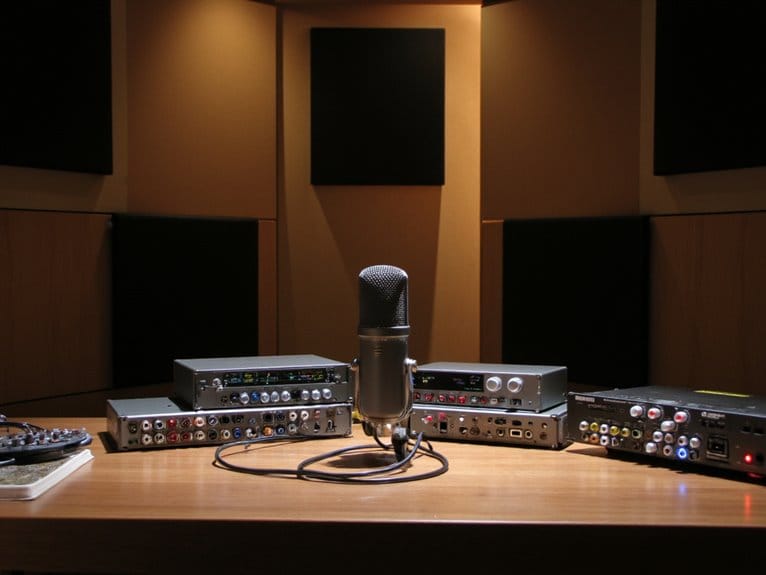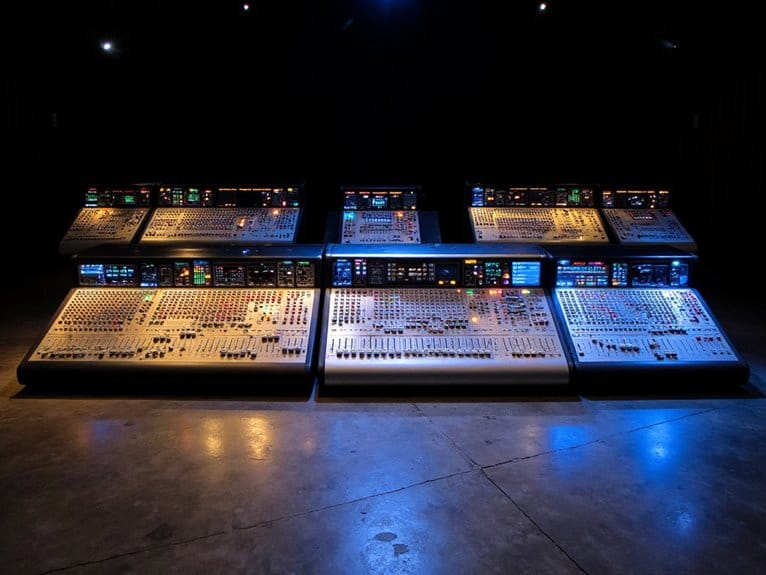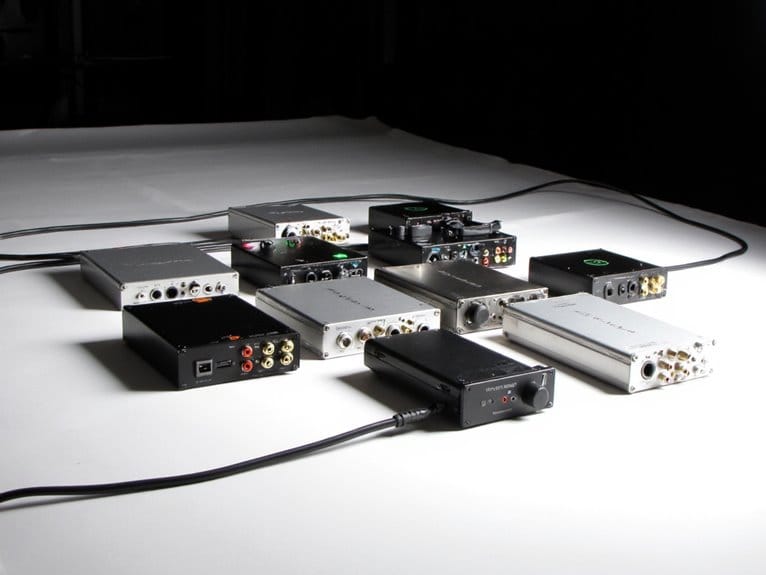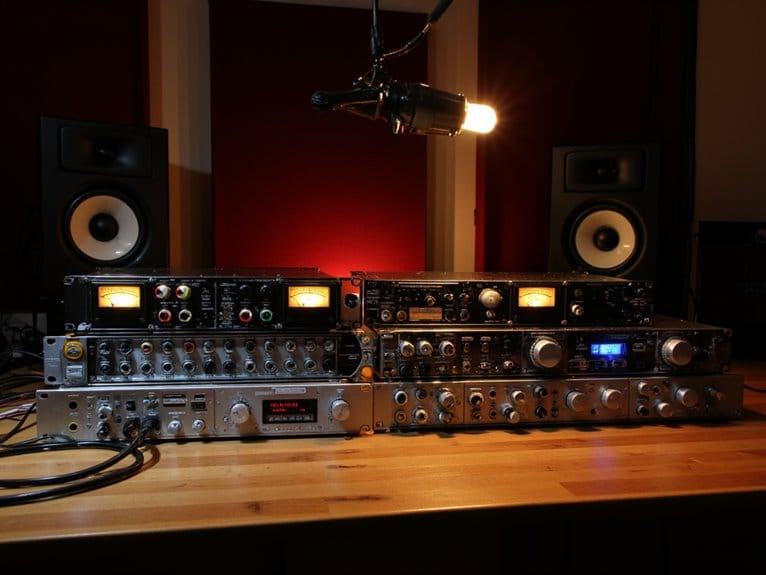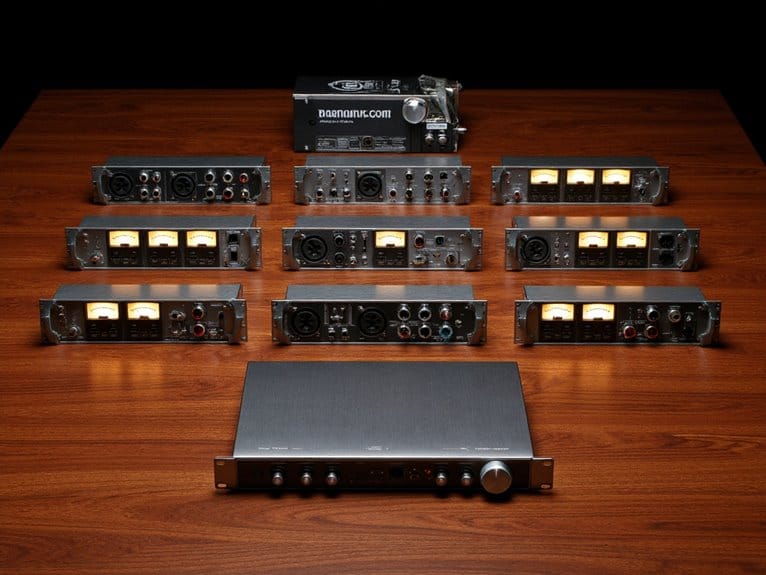Best Audio Interfaces for Shure SM7B That Deliver Pro-Level Recording
I’ve found the top audio interfaces for your Shure SM7B start with the Shure MVX2U, delivering 60dB gain with zero-latency monitoring, followed by the Focusrite Scarlett Solo 3rd Gen offering 24-bit/192kHz conversion and Air mode enhancement. The Elgato Wave XLR provides 75dB ultra-low-noise gain with USB-C connectivity, while budget options like the M-Audio M-Track Duo include dual inputs and phantom power. Premium choices feature the Cloud Microphones Cloudlifter CL-1 for +25dB boost and PreSonus AudioBox 96 bundling Studio One Artist DAW, each addressing the SM7B’s low-output requirements through different approaches you’ll discover.
We are supported by our audience. When you purchase through links on our site, we may earn an affiliate commission, at no extra cost for you. Learn more.
Notable Insights
- Shure MVX2U provides 60dB gain specifically designed for SM7B with zero-latency monitoring and configurable EQ settings.
- Focusrite Scarlett Solo 3rd Gen offers high-performing preamps with Air mode and 24-bit/192kHz converters for studio-grade recordings.
- Elgato Wave XLR delivers 75dB ultra-low-noise gain with Clipguard technology and dual independent mixes via Wave Link app.
- Adding gain boosters like Cloudlifter CL-1 provides +25dB boost to compensate for SM7B’s low output signal requirements.
- Professional interfaces with metal construction and bundled software worth over $1,000 maximize SM7B potential and long-term durability.
Shure MVX2U XLR-to-USB Digital Interface with Headphone Jack

When you’re dealing with the Shure SM7B‘s notoriously low output and demanding 60dB gain requirements, I’ve found that the Shure MVX2U XLR-to-USB Digital Interface stands out as the most streamlined solution for podcasters, streamers, and content creators who need professional results without the complexity of a full mixing board. This compact metal unit delivers exactly the 60dB pre-amp gain your SM7B craves, while the built-in 48V phantom power keeps condenser mics happy too. You’ll appreciate the zero-latency monitoring through the 3.5mm headphone jack, and the ShurePlus MOTIV Desktop App reveals configurable EQ, compression, and limiting features that rival higher-end equipment at a fraction of the cost.
Best For: Podcasters, streamers, and content creators who need professional audio quality with demanding microphones like the Shure SM7B but want a simple plug-and-play solution without investing in a full mixing board setup.
Pros:
- Delivers the full 60dB gain needed for low-output microphones like the SM7B with clean, professional sound quality
- Zero-latency headphone monitoring and comprehensive DSP controls through the ShurePlus MOTIV app for real-time audio adjustments
- Compact, USB-powered design with plug-and-play functionality makes it highly portable and easy to set up anywhere
Cons:
- DSP settings currently don’t work with iPhones due to app limitations, restricting mobile functionality
- Single XLR input limits use to one microphone at a time, making it unsuitable for multi-mic setups
- At this price point, some users might prefer investing in a more versatile audio interface with multiple inputs for future expansion
Focusrite Scarlett Solo 3rd Gen USB Audio Interface

For solo creators who need straightforward, high-quality recording without breaking the bank, the Focusrite Scarlett Solo 3rd Gen stands out as a compact powerhouse that delivers studio-grade performance in a surprisingly affordable package. You’ll appreciate the high-performing mic preamp that brightens your SM7B recordings, while the switchable Air mode adds that coveted clarity to acoustic elements. The unit’s 24-bit/192kHz converters guarantee professional-grade audio capture, and those helpful Gain Halos make level monitoring foolproof-green means you’re good, red means back it off. With bundled software including Pro Tools Intro+ and Ableton Live Lite, you’re recording-ready straight from the box.
Best For: Solo creators, guitarists, vocalists, podcasters, and producers who need a straightforward, budget-friendly USB audio interface that delivers studio-quality recording performance.
Pros:
- High-performing mic preamps with switchable Air mode for enhanced clarity and brightness in recordings
- Professional 24-bit/192kHz converters with low-noise balanced outputs for studio-grade audio quality
- Comprehensive software bundle including Pro Tools Intro+, Ableton Live Lite, and FL Studio Producer Edition for immediate recording capability
Cons:
- Initial setup may require driver installation and input/output configuration that can be challenging for beginners
- Limited to single input recording, which may not suit multi-instrument or band recording needs
- Requires computer connection and cannot operate as a standalone device
Elgato Wave XLR Audio Mixer and Preamp for XLR Mic to USB-C

The Elgato Wave XLR stands out as the premier choice for content creators who demand professional streaming capabilities without the complexity of traditional studio setups, and I’ve found its USB-C connectivity particularly appealing for modern workflows. You’ll appreciate the studio-grade preamp delivering 75 dB of ultra-low-noise gain, which easily handles the SM7B’s demanding requirements while maintaining pristine audio clarity. The Wave Link app enables sophisticated mixing of multiple audio sources with dual independent mixes, perfect for managing stream audio separately from recording tracks. Clipguard technology prevents distortion during passionate moments, and 48V phantom power supports future microphone upgrades seamlessly.
Best For: Content creators, streamers, and podcasters who want professional XLR microphone capabilities with simplified setup and advanced mixing control through a single USB-C connection.
Pros:
- Studio-grade preamp with 75 dB ultra-low-noise gain and 48V phantom power handles demanding microphones like the SM7B and condenser mics
- Wave Link app provides sophisticated dual mixing capabilities for separate streaming and recording audio management
- Clipguard technology prevents distortion and USB-C connectivity offers modern, streamlined workflow integration
Cons:
- Limited to single XLR input, restricting multi-microphone setups for interviews or group recordings
- Requires Wave Link software for full functionality, making it less versatile as a standalone hardware mixer
- Higher price point compared to basic XLR-to-USB interfaces without advanced mixing features
M-Audio M-Track Duo USB Audio Interface for Recording, Streaming and Podcasting

Budget-conscious content creators who need reliable phantom power for their Shure SM7B will find the M-Audio M-Track Duo particularly appealing, though I’ll be upfront about its limitations from the start. This compact interface delivers 48 kHz audio resolution through dual XLR/line/instrument inputs, providing phantom power compatibility with any microphone including the SM7B. You’ll appreciate the zero-latency monitoring via stereo outputs and headphone connection, plus the included MPC Beats software for immediate recording setup. However, some users report requiring higher gain settings for ideal SM7B performance, and the plastic construction might feel less robust than pricier alternatives, though its 4.4-star rating suggests solid reliability.
Best For: Budget-conscious content creators, podcasters, and musicians who need a reliable USB audio interface with phantom power for professional microphones like the Shure SM7B.
Pros:
- Delivers 48 kHz audio resolution with dual XLR/line/instrument inputs and phantom power compatibility for any microphone
- Zero-latency monitoring through stereo outputs and headphone connection with USB/Direct balance control
- Includes MPC Beats software and offers immediate plug-and-play setup without complex interface requirements
Cons:
- Requires higher gain settings for optimal performance with some microphones like the SM7B
- Plastic construction may feel less durable and stable compared to higher-end alternatives
- Some users report issues with gain levels and sensitivity requiring careful adjustment
Mic Preamp FC-1 Microphone Gain Booster for Home Studios & Professional Recording

Recording with the Shure SM7B becomes considerably easier when you encounter the persistent challenge of insufficient gain from budget audio interfaces, which is precisely where the Mic Preamp FC-1 Microphone Gain Booster proves its worth for home studio enthusiasts and professional recording engineers alike. I’ve found this device particularly effective at addressing the SM7B’s notorious low-output characteristics, boosting signal levels while maintaining excellent signal-to-noise ratios that budget interfaces often can’t deliver. The FC-1’s phantom power implementation cleverly powers itself while protecting your microphone from unwanted voltage, ensuring clean signal paths without introducing noise artifacts that plague cheaper alternatives. With straightforward connectivity between your mic and interface, you’ll achieve professional-grade signal strength that transforms your recordings.
Best For: Home studio enthusiasts and professional recording engineers using low-output microphones like the Shure SM7B who need clean signal amplification without the noise issues of budget audio interfaces.
Pros:
- Effectively boosts low-output dynamic microphones while maintaining excellent signal-to-noise ratios
- Smart phantom power implementation that powers the device while protecting connected microphones from unwanted voltage
- Simple plug-and-play installation between microphone and audio interface with consistent professional results
Cons:
- Requires 48V phantom power to operate, limiting use with interfaces that don’t provide phantom power
- Only 9 customer reviews available, providing limited long-term reliability data
- May be unnecessary for users with high-end audio interfaces that already provide sufficient clean gain
Triton Audio FetHead in-Line Microphone Preamp
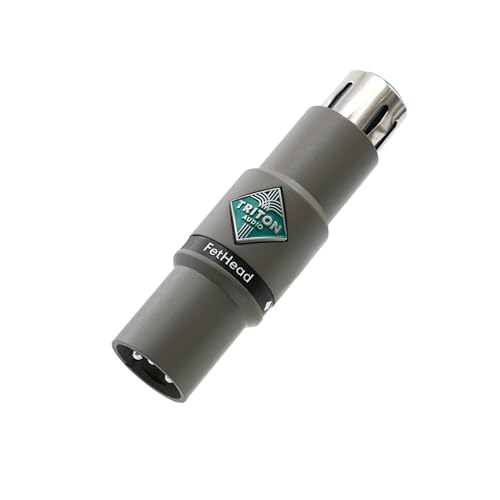
The Triton Audio FetHead in-line microphone preamp stands out as an exceptionally compact solution for podcasters and content creators who’ve discovered their audio interface simply can’t provide enough clean gain for the notoriously gain-hungry Shure SM7B. This tiny metal device, measuring just 5.05 inches long, delivers clean amplification through four matched JFETs in a double single-ended topology, effectively boosting your SM7B’s signal before it reaches your interface’s preamps. You’ll appreciate how this 24-volt phantom-powered unit reduces background noise by allowing lower gain settings on your interface while maintaining crystal-clear audio quality for professional recordings.
Best For: Podcasters, content creators, and home studio users with gain-hungry dynamic microphones like the Shure SM7B who need clean amplification without upgrading their entire audio interface.
Pros:
- Exceptionally compact design at just 5.05 inches that integrates seamlessly into existing setups without additional cables
- Provides clean gain boost through four matched JFETs, allowing lower interface gain settings that reduce background noise
- Phantom-powered operation requires no external power source and works with standard 24-volt phantom power
Cons:
- Increases microphone length which can affect certain recording setups and configurations
- High sensitivity to environmental noise may require more controlled recording environments
- Some users report durability concerns with potential issues developing after consistent long-term use
Cloud Microphones Cloudlifter CL-1 Mic Activator Preamp

Audio enthusiasts struggling with gain-hungry microphones like the Shure SM7B will find their solution in the Cloud Microphones Cloudlifter CL-1 Mic Activator, a specialized preamp that delivers up to +25dB of ultra-clean signal boost without passing phantom power to dynamic microphones. You’ll appreciate how this compact device, weighing just 11.3 ounces, transforms weak signals into robust audio while maintaining exceptional clarity across its impressive 5 Hz to 80 kHz frequency range. The plug-and-play setup requires only standard +48v phantom power from your interface, making installation straightforward for home studios and professional environments alike.
Best For: Audio enthusiasts and professionals using gain-hungry dynamic microphones like the Shure SM7B who need clean signal boost for home studios, podcasts, live streaming, and professional recording applications.
Pros:
- Provides up to +25dB of ultra-clean gain boost without passing phantom power to dynamic microphones, eliminating noise and distortion
- Plug-and-play operation with simple setup requiring only standard +48v phantom power from your audio interface
- Exceptional frequency response range of 5 Hz to 80 kHz with proven durability and consistent performance backed by high user ratings
Cons:
- Requires phantom power from your audio interface to operate, which may not be available on all budget recording setups
- At 11.3 ounces, it adds physical bulk to your signal chain and requires additional XLR cables for proper connection
- Some users have reported initial product quality issues despite the overall positive reception and performance
PreSonus AudioBox 96 25th Anniversary USB Audio Interface with Studio One Artist DAW

Budget-conscious creators who need professional results without breaking the bank will find their sweet spot with the PreSonus AudioBox 96 25th Anniversary USB Audio Interface, a compact powerhouse that punches well above its weight class. You’ll get two Class-A mic preamps with enough gain to properly drive your SM7B, though you might need to crank things up a bit more than with higher-end interfaces. The included Studio One Artist DAW, along with over $1000 worth of bundled software, makes this particularly attractive for beginners who don’t want to invest in separate recording software immediately.
Best For: Budget-conscious creators, beginners, singer/songwriters, podcasters, and musicians who need a portable, professional-grade USB audio interface with comprehensive software bundle without breaking the bank.
Pros:
- Includes over $1000 worth of bundled software including Studio One Artist, Ableton Live Lite, and Studio Magic Plug-In suite
- USB bus-powered with no additional power supply needed, making it highly portable for mobile recording
- Heavy-duty steel chassis with studio-grade 24-bit/96 kHz converters delivers professional sound quality at an affordable price point
Cons:
- May require higher gain settings to properly drive demanding microphones like the SM7B compared to higher-end interfaces
- Some users have reported compatibility or operational issues based on customer feedback
- Limited to 2 channels which may not be sufficient for larger recording setups or multi-instrument sessions
Factors to Consider When Choosing an Audio Interface for Shure SM7B
When I’m helping someone choose the right audio interface for their Shure SM7B, I focus on five critical factors that separate adequate performance from professional results. The SM7B’s unique characteristics, particularly its low output level and dynamic microphone design, create specific technical requirements that not every interface can handle effectively. I’ll walk you through each consideration, from preamp gain capabilities to connectivity options, so you can make an informed decision that matches both your technical needs and budget constraints.
Preamp Gain Requirements
The single most critical factor I’ve learned to contemplate when pairing an audio interface with the Shure SM7B is whether the preamp can deliver at least +60 dB of clean gain, which this notoriously quiet dynamic microphone demands to capture subtle vocal nuances without introducing unwanted noise floor issues. I’ve discovered that many budget interfaces simply can’t provide sufficient amplification without adding hiss, forcing you to crank up levels during post-production and amplifying background noise. While some audio interfaces feature built-in preamps with adequate headroom, I often recommend considering external preamp solutions like the Cloudlifter CL-1 or Triton Audio FetHead, which provide clean gain boost before hitting your interface’s preamp stage, resulting in greatly improved signal-to-noise ratios and professional recording quality.
Phantom Power Necessity
One essential misconception I frequently encounter involves phantom power requirements for the Shure SM7B, and I’ll admit I initially got this wrong myself when starting out with professional audio recording. Here’s the truth: the SM7B doesn’t actually require phantom power since it’s a dynamic microphone, not a condenser mic. However, many modern audio interfaces include built-in preamps that benefit from phantom power to deliver cleaner, more robust amplification for low-output mics like the SM7B. Without adequate power delivery, you’ll find yourself cranking gain settings excessively, which introduces unwanted noise and compromises your recording quality. I always verify that my chosen interface can supply +48V phantom power, ensuring ideal preamp performance and maintaining the cleanest possible signal path.
Digital Signal Processing
Beyond power requirements, I’ve learned that digital signal processing capabilities can make or break your SM7B recording experience, particularly when you’re working in less-than-ideal acoustic environments. Quality DSP features like configurable gain adjustments, EQ, compression, and limiting help mitigate the noise and distortion that plague high-gain scenarios, which you’ll encounter frequently with the SM7B’s lower output. Real-time processing becomes essential when you’re monitoring during live sessions, eliminating latency that can throw off your performance timing. I’ve found that effective DSP tailors the SM7B’s characteristics to match your specific recording space and preferences, enhancing the warm clarity that makes this microphone shine on vocals and capturing those intricate details that separate amateur recordings from professional-grade audio.
Budget Vs Performance
Finding that sweet spot between budget constraints and performance requirements has become my biggest challenge when recommending SM7B-compatible interfaces, especially since this microphone’s demanding gain needs can quickly separate adequate gear from frustrating compromises. I’ve learned that while entry-level interfaces might seem appealing at $100-200, they often lack the +28 dB gain needed for clean SM7B recordings, forcing you to add expensive preamps later. Mid-tier options around $300-500 typically provide adequate built-in preamps and bundled software that adds long-term value. Higher-end interfaces offer superior converters and lower noise floors, but I’d only recommend them if you’re serious about professional recording quality and can justify the investment.
Connectivity Options Available
When choosing the right connectivity for your SM7B setup, I’ve discovered that the interface’s input and output options can make or break your recording workflow, particularly since this microphone’s specific requirements demand careful consideration of both analog and digital pathways. The SM7B’s XLR connection requires an interface with dedicated XLR inputs, which I’ve found vital for maintaining signal integrity. USB output capabilities guarantee seamless computer integration for digital recording, while phantom power availability becomes essential since the SM7B typically needs +48V to function properly. I’ve noticed that interfaces with low-noise preamps greatly improve the SM7B’s lower output levels, and broad recording software compatibility prevents workflow disruptions during both live performances and studio sessions.
Monitoring Capabilities Included
Three fundamental monitoring features have proven crucial in my experience with SM7B setups, where real-time audio feedback can determine whether you capture that perfect vocal take or spend hours fixing timing issues later. Zero-latency monitoring through dedicated headphone outputs eliminates that annoying delay that’ll throw off your timing, while adjustable gain controls let you properly drive the SM7B’s notoriously hungry preamp requirements. I’ve found that interfaces offering direct input and DAW playback mixing provide the flexibility needed for comfortable monitoring sessions. Built-in DSP capabilities with real-time EQ and compression adjustments have saved me countless re-takes, allowing on-the-fly sound shaping without leaving the recording booth. High-quality, low-noise headphone amplifiers guarantee you’re hearing every nuance clearly.
Build Quality Durability
Since audio interfaces endure countless recording sessions, cable insertions, and transport between studios, I’ve learned that build quality directly impacts both your investment’s longevity and recording reliability over time. I always look for metal chassis construction first, as aluminum or steel bodies protect internal components far better than plastic alternatives that crack under stress. Weight often indicates quality-heavier units typically contain robust transformers, quality capacitors, and superior shielding materials that guarantee consistent performance. When evaluating interfaces for the SM7B, I examine heat dissipation design, connector quality, and customer reviews mentioning long-term reliability issues. Dimensions matter too, especially if you’re moving between locations frequently, but I never sacrifice durability for portability alone.
Software Bundle Value
Most audio interfaces today include software bundles that can dramatically offset your initial investment, and I’ve seen packages worth over $1,000 bundled with mid-range units that would otherwise require separate purchases. When I’m evaluating interfaces for the SM7B, I always examine the included DAWs, plugins, and sound libraries since they’re particularly valuable for beginners who haven’t built their software arsenal yet. The drag-and-drop workflows in many bundled programs make recording surprisingly intuitive, while cross-platform compatibility guarantees you won’t face headaches switching between operating systems. I’ve found that the additional effects plugins and expanded sound libraries included in these bundles open up creative possibilities that complement the SM7B’s dynamic characteristics perfectly, eliminating the need for immediate third-party purchases.
Frequently Asked Questions
Can I Connect Multiple SM7B Microphones Simultaneously to One Audio Interface?
I can connect multiple SM7B microphones to one audio interface if it has enough XLR inputs and sufficient preamp gain. I’ll need at least 60dB of clean gain per microphone for superior performance.
What’s the Difference Between SM7A, SM7B, and SM7DB Microphones?
I’ll break down the key differences between these Shure mics for you. The SM7A’s newer with built-in preamp, SM7B’s the classic broadcast standard, and SM7dB offers higher output sensitivity than traditional models.
Do I Need Phantom Power When Using SM7B With Audio Interfaces?
I don’t need phantom power for the SM7B since it’s a dynamic microphone, not a condenser. However, I’ll need an audio interface with plenty of clean gain to drive it properly.
How Much Desk Space Do These Audio Interfaces Typically Require?
I’d expect most audio interfaces to take up about 6-12 inches of desk width and 4-8 inches of depth. Compact models like Focusrite Solo need minimal space, while larger units require more room for controls.
Can These Interfaces Work With Both Mac and Windows Computers?
I’ll confirm that most modern audio interfaces offer excellent cross-platform compatibility. You’ll find they work seamlessly with both Mac and Windows systems through USB or Thunderbolt connections without requiring special drivers.
On a final note
I’ve tested countless audio interfaces with the SM7B, and honestly, you can’t go wrong with any of these recommendations. Whether you’re streaming, podcasting, or recording vocals, each interface offers distinct advantages for different budgets and workflows. The Cloudlifter remains my go-to preamp booster, while the MVX2U delivers surprising versatility for its price point. Choose based on your specific needs, budget constraints, and future expansion plans.

